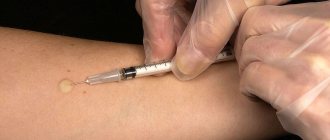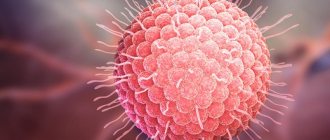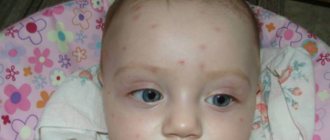Almost everyone believes that children easily tolerate chickenpox, unlike adults. Parents of children often ask the question: “Is it worth limiting contact with a sick child?” Some even seriously think about: maybe deliberately infecting their child with chickenpox, that is, going to visit a chickenpox patient.
Today we’ll talk about the feasibility of this approach to the issue.
Chickenpox (scientifically called chickenpox) is one of the most common childhood infections. It is considered a highly contagious infection, that is, it is easily transmitted through contact with a patient.
This happens because the Varicella Zoster virus (the causative agent of chickenpox) is persistent in the external environment and spreads easily. This is also due to the general susceptibility to the virus.
The causative agent of chickenpox belongs to the herpes virus group (type 3). It is equally capable of affecting both adults and children.
In adults, this type of virus most often causes shingles, causing clustered rashes to appear on the torso or face. The disease is accompanied by severe pain and high fever.
In children, infection with the Varicella Zoster virus occurs in the form of chickenpox.
Chickenpox most often affects children in a mild form. If a person becomes ill as an adult, then in 90% of cases chickenpox is severe.
The incubation period, that is, the period from the moment of contact with the patient until the appearance of the first signs of the disease, lasts 9-21 days. Therefore, the chickenpox quarantine lasts 21 days.
It is worth considering that the child becomes contagious one or two days before the first elements of the rash appear. In other words, we do not yet know that the child is sick, but he is already a source of infection for others.
The main symptoms of chickenpox in children:
- elevated body temperature in the first two to three days of illness;
- headache;
- enlarged lymph nodes;
- slight weakness, poor appetite;
- when a rash appears on the oral mucosa - pain when eating;
- itchy skin rash;
- Typical stages of development of chickenpox elements: pink spot, papule (nodule), vesicle with a red border, crust.
- the rash is polymorphic, that is, in one area of the body there may be a spot, a blister, or a crust;
- The period of appearance of new elements of the rash lasts on average 5-7 days.
After chickenpox, lifelong immunity is formed. A person should not get sick again.
However, in isolated cases, cases of re-infection have been reported. The reason for this may be any human immunodeficiency condition.
Can a child get chickenpox again?
In the mid-70s, it was found that a child’s body, unlike an adult’s, is subjected to a more serious test after chickenpox. For this reason, children always have a chance of becoming infected again. Recurrence of chickenpox in children is much more complicated, since more disorders are observed in the body. Even vaccination does not provide complete guarantee of protection against the virus. It has been scientifically proven that the vaccine can also cause changes that occur in the immune system and lead to re-infection upon contact with the patient.
Chicken pox is accompanied by the following symptoms:
- body temperature rises, chills and weakness appear;
- gradually a rash appears on all parts of the body;
- the rashes have a relief structure and first appear on the palms;
- After the rash, itching appears.
When re-infected, the healing of the rash takes much longer and is more difficult. Very often, the disease is accompanied by other secondary infections, which can worsen the patient’s condition. If complications develop, the risk of death of the patient increases.
However, there are specialists who are confident that the likelihood of chickenpox recurrence is very small or completely impossible. It is possible to say that chickenpox, once suffered, will never happen again, is possible only in cases where the immune system is healthy. Any deviations in the functioning of the immune system can lead to irreversible consequences. Therefore, only the attending physician can answer the question of whether chickenpox can recur in children after prescribing tests and examinations.
How many times do you get chickenpox in your life?
How many times a person gets sick depends directly on the state of the immune system. For most people, an encounter with the cause of smallpox, the Varicella-Zoster virus, ends with a one-time event - children usually suffer from the disease in the first ten years of life, after which a strong immunity is formed, and Varicella-Zoster no longer bothers the baby.
Due to the prevailing myth that you can get chickenpox once in your life, some parents deliberately arrange contacts between sick children and healthy ones in order to get sick with herpes of the third type in childhood. The effectiveness of such contacts is not always positive - even with close contact, the baby may not get sick.
In part, there is a rational grain here and children in preschool and primary school age actually get sick the most easily. But this does not mean that a herpetic rash will never appear on the skin again and the person will not get sick later. After all, the mechanism for the appearance of repeated episodes changes slightly.
If in childhood smallpox occurs due to the lack of antibodies to a specific pathogen, then secondary cases indicate a strong decrease in immunity when the body does not have enough strength to fight the activated pathogens. According to doctors' observations, adults can have several episodes of herpes, like other diseases.
In this case, the course of smallpox has its own specifics, because it appears already with reduced protective forces, and now the pathogen itself puts even more stress on the body and lowers immunity. It is not surprising that after suffering from an illness a person develops serious complications.
Secondary episodes of chickenpox are called herpes zoster - this is a special form of chickenpox. It usually manifests itself locally, chickenpox blisters appear crowded, mainly in the back area on the lower back, which is why it is called shingles. The number of bubbles is usually smaller, but this does not alleviate the patient’s condition.
Factors contributing to re-infection with chickenpox
Chickenpox reappears for various reasons. The main factors provoking relapse include:
- Misdiagnosis. Medical error is one of the most common causes. When the first symptoms appeared, the doctor could have made a mistake and made an incorrect diagnosis. Chickenpox can be confused with other similar diseases, for example, streptoderma, impetigo, herpes, herpangina or strophulus. Even the bites of some animals have similar symptoms to chickenpox. There are cases when children are diagnosed with repeated chickenpox when infected with herpes zoster. The symptoms of these diseases are also very similar.
- Little age. If a child had chickenpox for the first time in infancy, then immunity may not have developed. Since the child’s immune system begins to produce antibodies only closer to 3–4 years of age. In cases where the child is breastfed, the antibodies in the milk can help the child survive the disease much easier and without negative consequences.
- Immunity impairment. The answer to the question of how many times a child can get chickenpox interests many parents. Especially those whose children suffer from impaired immunity, which appeared as a result of the following circumstances: HIV, chemotherapy, acquired immunodeficiency, after suffering a blood disease, benign cancer tumors, when taking glucocorticosteroids, during internal organ transplantation.
The mild form of the disease, in turn, is divided into two subtypes: abortive and erased. The abortive stage begins immediately with the appearance of the papule and proceeds without the formation of a vesicle. Body temperature at this stage may not rise at all. The erased stage is characterized by minimal rashes, the bubbles are very small.
Chickenpox is a mild disease
The course of chickenpox varies. Sometimes the bubbles can be counted on one hand, the temperature does not rise, and the child feels well. In other cases, there are a lot of rashes, new ones constantly appear, the temperature rises to 39-40 degrees. The child becomes lethargic, tearful, and his appetite worsens.
In rare cases, chickenpox becomes anything but harmless. With the pustular form, pustules appear on the skin, the disease lasts longer and is more severe. Visible scars may remain in place of the pustules. Sometimes large blisters filled with cloudy liquid appear. When they burst, they leave a wet surface - an ideal gateway for infection. In the hemorrhagic form, scabs and ulcers remain in place of the vesicles.
The chickenpox virus can cause laryngitis with suffocation, pneumonia, encephalitis, and meningitis. The disease is especially severe when the rash occurs not only on the skin, but also in the internal organs. This type of chickenpox is called visceral.
Severe course with complications usually occurs in children with reduced blood pressure, weakened by other diseases, and treated with drugs that suppress the immune system.
How to prevent re-infection
Timely vaccination is considered an effective preventive measure against re-infection with chickenpox. The chickenpox vaccine is called Varilrix and protects against infection for 7-20 years. At the same time, the immune system develops stable protection against the chickenpox virus.
To obtain more complete information on this issue, as well as to protect your child from medical error, you should contact a highly qualified infectious disease doctor. In order to establish an accurate diagnosis, the doctor will prescribe a serological blood test. When infected with an infection, the amount of antibodies in the blood will be 4 times greater.
All information about possible re-infection should first of all be known to those parents whose children have a weakened immune system, any chronic disease, or were ill at an early age and in a very mild form. All these children need extra attention. To avoid serious consequences and not become infected again, they are advised to take various measures to strengthen the immune system, eat well, maintain a daily routine and hygiene rules, and also exercise regularly.
Chickenpox can be contracted through objects
Although chickenpox is highly contagious, the virus can only live in the human body. Once in the environment, it quickly dies. Therefore, the likelihood of becoming infected through objects and third parties is extremely low.
You can “catch” chickenpox through airborne droplets, just like an acute respiratory infection. However, this does not require being near the patient. The virus easily spreads to adjacent rooms and even to adjacent apartments. You can get sick if you come into contact with the fresh saliva of an infectious person or with the liquid that is in the bubbles: in the first 5 days of the disease, the concentration of viruses in it goes off scale.
Specifics of treatment for re-infection with chickenpox in children
How to treat recurrent chickenpox in children? The symptoms and treatment are almost the same as in the first case. You can reduce a child's body temperature during re-infection with paracetamol. Antihistamines, as well as Fukortsin ointment or brilliant green, will help relieve discomfort and itching from the rash. A patient with chickenpox should never wet the rash with water during the first 3 days (at the time of their active growth), or take a bath. Since during this period the appearance and maturation of blisters occurs.
Differences from lichen
The second chickenpox is also called shingles, which is similar in nature to the rash, but its symptoms are slightly different:
- the rash does not appear throughout the body, but is localized in a certain area in a small area;
- the areas of the rash itch, burn and hurt;
- small blisters are opaque and filled with pus or blood, depending on the degree of infection.
Repeated chickenpox, or shingles, are unpleasant diseases that are difficult to tolerate and, due to the unbearable itching that appears, may leave scars or welts on the skin area after recovery.
Important: During repeated chickenpox and shingles, it is necessary to observe quarantine so as not to infect others; it is better to communicate with them by telephone or using Internet technologies.
Possible complications
Many specialists, when re-infected, warn their patients about a possible severe form of the disease.
- In some cases, the temperature lasts longer than usual, and it is quite difficult to reduce it.
- Patients experience severe skin itching, which does not disappear even after treatment with special means.
- If a secondary infection occurs, serious complications may occur. Cases of complete or partial loss of vision that arose as a result of repeated infection have been recorded.
- Deafness, meningitis, postherpetic neuralgia, encephalitis, and severe dizziness may occur.
- Cases of exacerbation of existing chronic diseases have also been recorded.
All these complications can appear in a child if he is re-infected, even if he suffered the disease at an early age. If a child had chickenpox at the age of 2–4 years, and the disease was severe, then with a secondary infection it will be much easier, that is, with a minimal amount of rash and moderate temperature.
Features of the course of herpes zoster
Shingles occurs a little differently than chickenpox. A few days before the appearance of obvious symptoms of the disease, a person is faced with a feeling of severe malaise. He is worried about noticeable weakness, headaches, and aches in the joints may occur. Also, activation of the virus may be accompanied by fever and chills. Quite often, in areas of future rashes, a feeling of pain, unpleasant burning and itching appears. These areas may also experience numbness and tingling.
After a few days (one to four), rashes appear on the skin. The temperature usually remains high and can reach forty degrees. The rashes initially look like pinkish spots, and over time transform into blisters filled with transparent contents (which is also typical for chickenpox). Most often, the rash is unilateral, occurring along the nerves on the patient’s body. In the vast majority of cases, it is localized in the chest area, less often on the face. The rash is painful and may burn and itch. Sometimes the rash causes particularly severe discomfort, even unbearable pain.
Over time, the rash dries out and becomes crusty. With normal immunity, recovery occurs in two weeks to one month.
The main feature of herpes zoster is that pain after such a disease can bother the patient for a very long time, which is classified by doctors as postherpetic neuralgia.
As you know, chickenpox does not require targeted therapy if it proceeds without complications. But with the development of herpes zoster, effective treatment helps speed up recovery, eliminate pain and avoid the unpleasant consequences of the disease (the same as postherpetic neuralgia).
Therefore, patients with this disease are prescribed antiviral medications containing acyclovir, famciclovir or valacyclovir. They are able to integrate into the DNA of viruses, interfering with their reproduction. To eliminate painful symptoms, non-steroidal anti-inflammatory drugs are usually used. Ibuprofen is often the drug of choice; ketorolac or naproxen, etc. can also be used. Doctors may prescribe additional medications to patients, for example, amantadine sulfate.
Shingles in the vast majority of cases ends in a successful recovery. Complications are possible with a catastrophic disorder of the immune system. In such situations, treatment of this pathology is carried out exclusively in the inpatient department.
Thus, the secondary development of chickenpox is a common myth that has no scientific evidence. When the chickenpox virus is reactivated in the body, a completely different disease develops - shingles.
Almost everyone knows that you only get chickenpox once, and it’s best to get over it in childhood. Then immunity will be formed, and the highly contagious disease will no longer be scary.
But is this really so? Is there still a risk of re-infection with chickenpox?
Doctors' opinion
Does recurrent chickenpox occur in children, as experts believe? Many doctors, including the famous pediatrician E. O. Komarovsky, believe that most children get chickenpox before the age of 12. Children over 12 years of age, as well as adults, suffer from the disease much more difficult. Re-infection with chickenpox is always characterized by more severe symptoms and in most cases is very difficult. Komarovsky recommends treating the disease for adults with antiherpetic drugs, but not aspirin. The same goes for treating children. It has long been proven that aspirin can cause complications with the liver.
To treat rashes, most parents still use a solution of brilliant green, believing that it disinfects and relieves itching. Dr. Komarovsky believes that brilliant green is completely powerless in the fight against chickenpox. Its main purpose is to track new papules. To do this, every morning you need to mark new rashes with brilliant green. As soon as the papules stop appearing, on the 5th day the child will be non-infectious and the disease will recede.
It should be remembered that chickenpox greatly impairs the immunity of a small child, so after recovery it is recommended not to attend kindergarten for about 3 weeks. As a strengthening effect, doctors recommend leading a healthy lifestyle and starting to take vitamins. Most doctors agree on the need for early vaccination against chickenpox, especially for children at risk.
Methods to reduce the risk of recurrence of the virus
As we said earlier, reactivation of the virus occurs due to a decrease in the functioning of the body's immune system. Based on this, we can conclude that the surest way to reduce the risk of possible re-infection and herpes zoster is to support the stable functioning of the body’s protective functions.
What you need to do for this:
- Eat properly and balanced. It is necessary to include in your diet foods that contain vitamins, namely fresh vegetables and fruits. It is also worth paying attention to products containing animal and vegetable protein. Suitable products include: meat, fish, eggs, beans, peas, milk, buckwheat and oatmeal;
- To maintain the functioning of the immune system, you can periodically take a course of multivitamins;
- Lead a healthy lifestyle. Include exercise in your routine and eliminate smoking and alcohol. Bad habits have a very detrimental effect on the immune system;
- Severe stress also affects the stability of the body’s protective functions, so it is worth reacting more calmly to negative situations;
- Enjoy life more often and laugh more. It’s not for nothing that they say that “laughter prolongs life”;
Results
Secondary infection with chickenpox is quite possible and easily explained using immunology. A second illness, as a rule, is much more severe than the first, but there are exceptions. First of all, the risk group includes children of any age with acquired or congenital immunodeficiency. At the slightest suspicion of re-infection with chickenpox, parents should immediately contact a specialist. Only a doctor can make an accurate diagnosis and prescribe appropriate treatment.
Watch
How children under one year of age suffer from chickenpoxTemperature with chickenpox in childrenWhat is the name of the chickenpox vaccine for childrenHow to treat chickenpox in children
Possible diagnostic errors
What is the likelihood of a misdiagnosis? There are several types of herpetic infections, manifested by rashes on the skin and mucous membranes. Therefore, cases of misdiagnosis cannot be excluded. It all depends on the competence of the doctor and laboratory technician conducting the analysis.
A personal examination of the patient by a specialist with a survey of the patient or his relatives is important. Ideally, when a rash appears, you should contact an infectious disease specialist: this specialist doctor will evaluate the nature of the rash, the accompanying symptoms, and determine whether it is chickenpox or another type of herpes.
In complex, difficult to diagnose cases, the patient may be prescribed serological tests for the presence of antibodies to herpes, which causes chickenpox. One of the most reliable methods today is PCR. To carry out the analysis, blood is drawn in the morning on an empty stomach.
Treatment of chickenpox
Although the symptoms of the disease are more pronounced and severe the second time, the treatment is practically no different from what was used the first time.
Simply, in the absence of clear and accurate indicators, we should not strengthen the child’s body. There is also a problem for adults with a chronic illness or cancer who live with young children. Then the first age group is recommended to have the vaccine.
Comparative characteristics of herpes viruses
Does chickenpox pose a risk to pregnant women? There is a risk that the virus is aggressive, nervous and affects the central nervous system. It also attacks the immune system. The question is quite delicate, it depends on the pregnancy. At the beginning of pregnancy there is no danger, then there are no organs that will be affected, but when there is a developed fetus and nervous system, then the risk is great. But after the third month, we cannot easily break the pregnancy.
First of all, to stabilize the patient’s condition, it is necessary to reduce the temperature with antipyretic drugs. It rises very strongly during secondary infection with chickenpox.
Antihistamines and sedatives. Antiviral drugs are also taken to treat chickenpox. The patient should follow a diet and diet, refrain from spicy and salty foods.
This is a very responsible and serious decision. There is very little risk of developing any damage to the fetus or having a baby with birth defects. Pregnant women are monitored for the severity of the disease. If there are complications, the fetus is removed all the time. We cannot use traditional drugs because they are contraindicated during pregnancy.
While a woman is pregnant, vaccination is not recommended, but if pregnancy is planned, it is advisable. In principle, this is a culture of fetal preservation; it should begin with consultation of women. But rubella is sometimes a more dangerous infection than chickenpox. The most important thing is to explain to a pregnant woman how to protect herself if not. There must be a culture of health of isolation from contact with infectious diseases. Walk less in shopping centers and movie theaters, where there is more coughing, and avoid contact with people they know are sick.
Water procedures are permitted if the patient’s condition has stabilized and the temperature has decreased. The time spent in the shower should be reduced to a minimum. The use of washcloths and sponges is prohibited.
A solution of brilliant green (“zelenka”) in this case plays the role of a marker and helps to monitor the development of the disease, in particular, skin rashes.
Smallpox became a widespread disease for the general public. Over the past few years, its incidence has expanded so much that there is no longer a person who could not encounter this disease, either personally or in the form of someone close to him. The disease has become so common that it is called classical. The disease is coming to the awareness of the general public, and when it comes to someone, it will not surprise anyone. In the Czech Republic, the disease occurs twice as often as usual.
Because of this, chickenpox is a well-known disease and is the subject of discussion forums in many magazines. The disease is so common that most readers have been around for a long time. Many people don't remember this because it was so long ago that they simply didn't know about it. Thus, almost every one of us has experienced this disease and knows it very well. He can talk about their symptoms and complications. The risk is only present in pregnant women. There may be some complications here. But otherwise, the disease is currently one of the most common.
Immunity after chickenpox
It is believed that immunity after illness is stable and lasts throughout life. Therefore, it is possible to get sick again, but it is extremely rare. There must be serious reasons for this. After treatment, the Varicella Zoster virus does not disappear from the body, but continues to remain in it, hiding in the nerve ganglia. Under certain conditions, hypothermia, stress, decreased immunity, the virus can become active again and appear in the form of itchy rashes. However, most often this occurs along the nerve trunks (large nerve fibers) and this disease is called herpes zoster. A chickenpox-type rash occurs extremely rarely. So, to the question whether a child can get chickenpox a second time, we answer positively. But we draw your attention to how small this probability is. What could be the reason for this?












